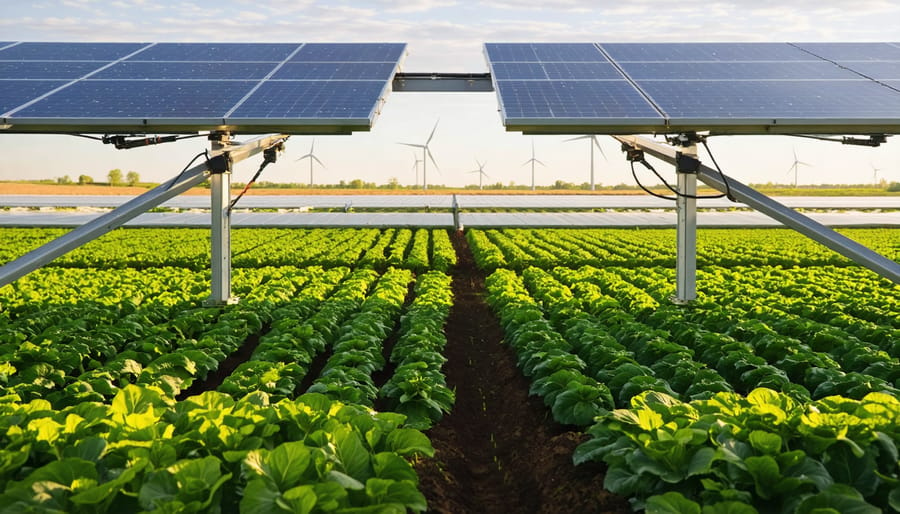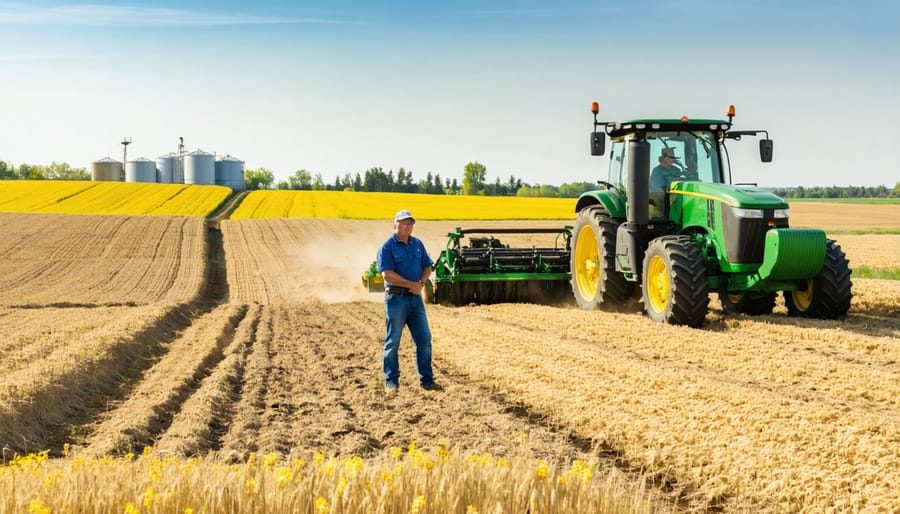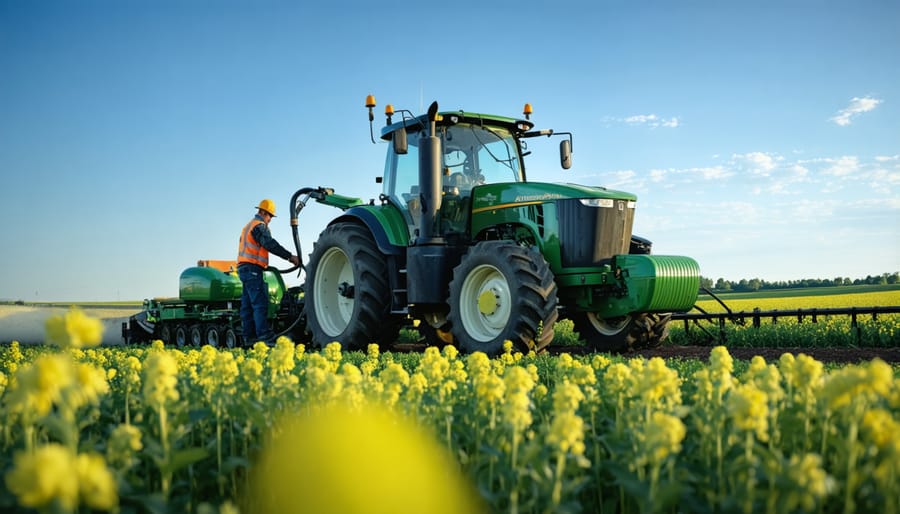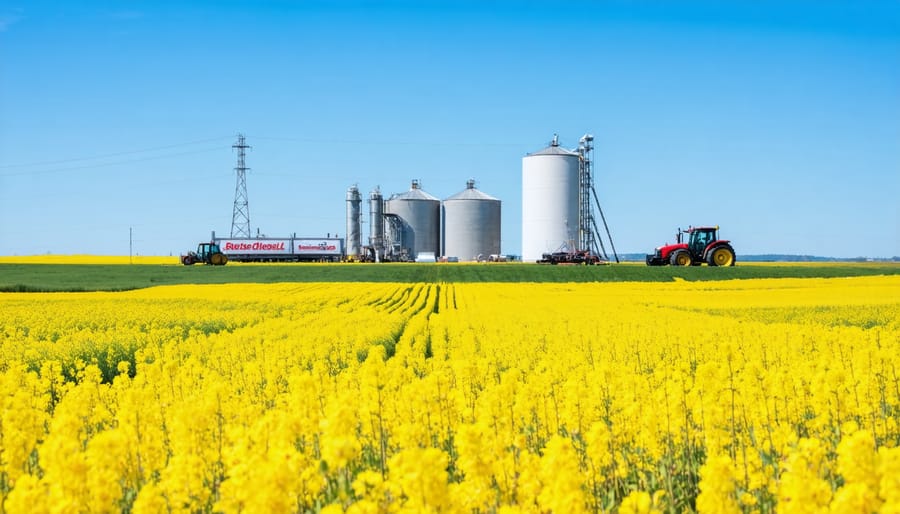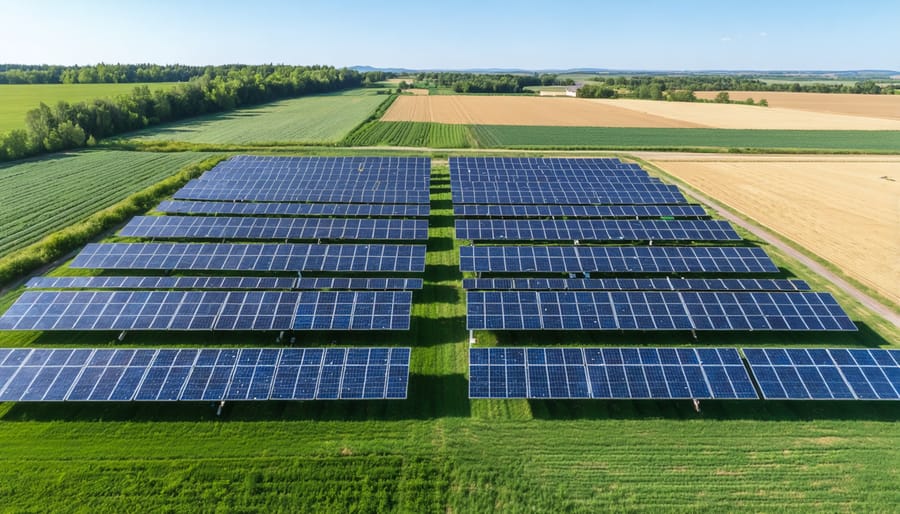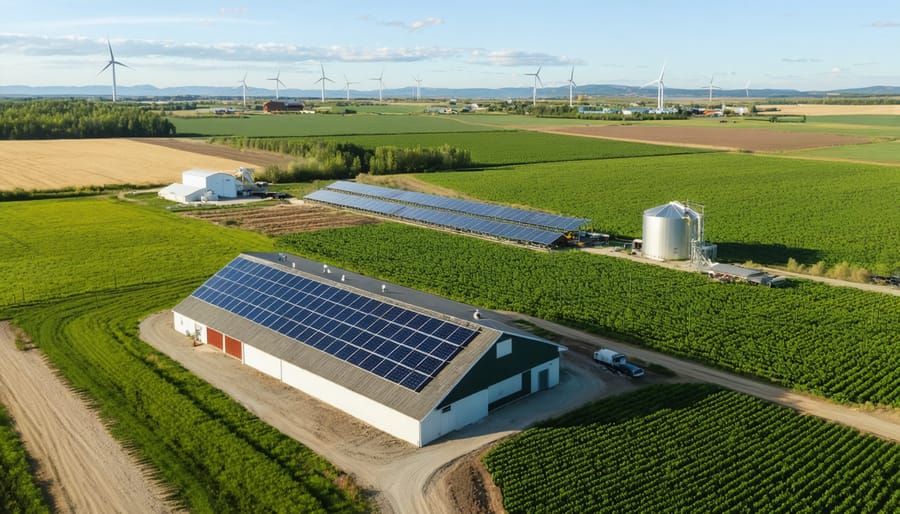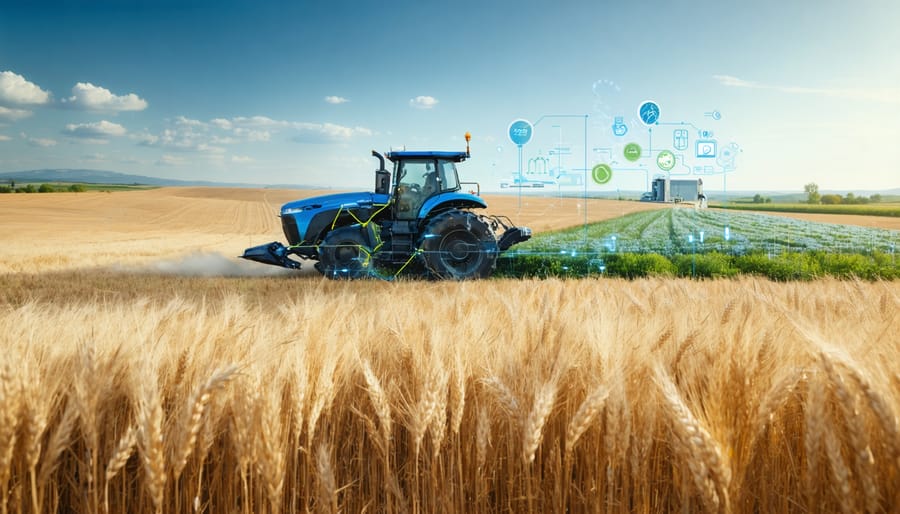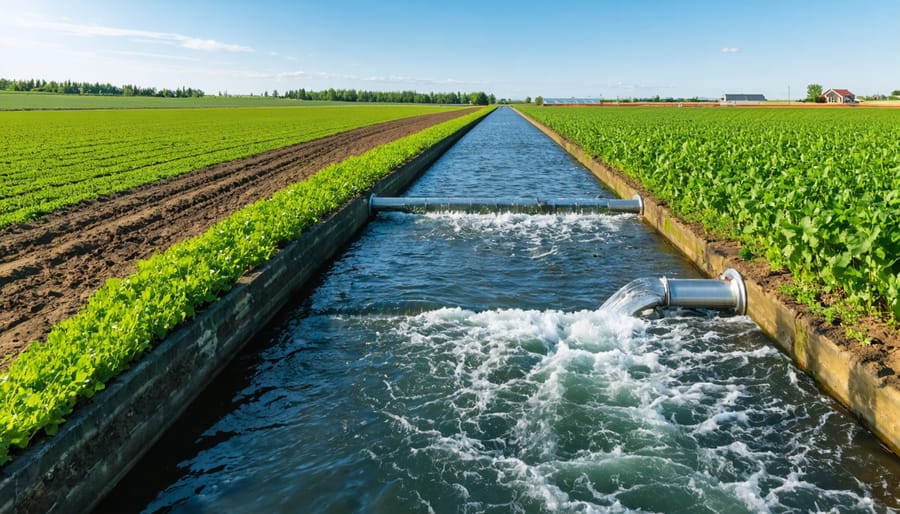Transform your agricultural operations with smart grid integration that’s revolutionizing modern farming across Alberta. Advanced power management systems, paired with proven sustainable farm solutions, now enable precise control over irrigation systems, greenhouse climate management, and livestock facility operations—all while reducing energy costs by up to 40%.
Canadian farmers implementing smart grid technology are reporting dramatic improvements in operational efficiency, with real-time monitoring systems detecting equipment failures before they occur and automated load-balancing ensuring optimal power distribution during peak usage periods. These intelligent systems integrate seamlessly with existing renewable energy sources, including solar arrays and wind turbines, creating a resilient power network that maintains consistent operation even during grid disruptions.
The latest smart grid innovations specifically designed for Alberta’s unique agricultural landscape combine robust weather prediction algorithms with automated response systems, enabling farmers to maintain ideal growing conditions while minimizing energy waste. This technology has become particularly crucial as more operations expand into year-round production, requiring sophisticated power management solutions that adapt to seasonal demands while maintaining cost-effectiveness.
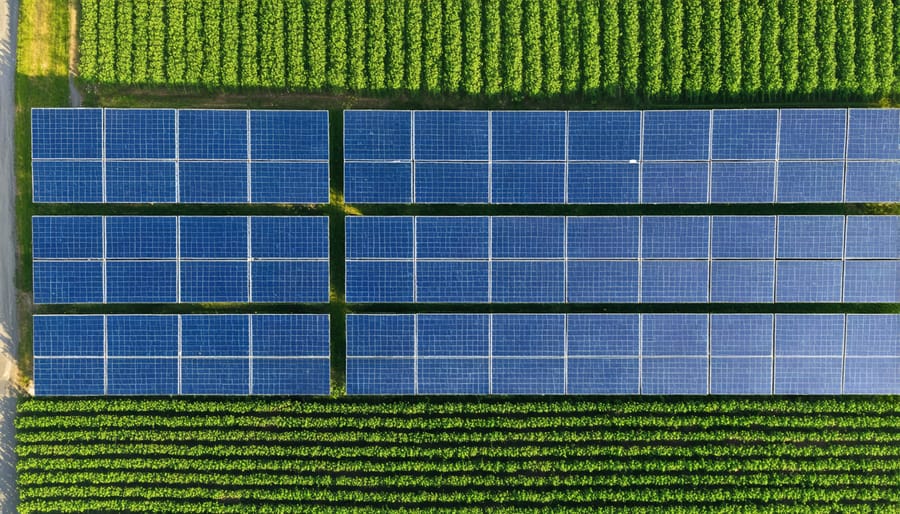
How Smart Grids Transform Alberta’s Agricultural Landscape
Real-Time Energy Management for Farm Operations
Smart grid technology enables farmers to monitor and manage their energy consumption in real-time, leading to significant cost savings and improved operational efficiency. Through smart meters and energy management systems, farmers can track power usage across different areas of their operation, from irrigation systems to barn climate control.
A notable example comes from the Lethbridge region, where dairy farmer Mike Thompson reduced his energy costs by 25% after implementing smart grid monitoring. “Being able to see exactly when and where we’re using the most power has helped us make smarter decisions about when to run certain equipment,” Thompson explains.
The system provides instant alerts when energy consumption spikes, allowing farmers to quickly address issues like malfunctioning equipment or inefficient processes. Many Alberta farmers are using these insights to schedule energy-intensive tasks during off-peak hours when electricity rates are lower.
Through mobile apps and web portals, farmers can access their energy data anywhere, making it easier to manage multiple properties or monitor operations remotely. The technology also helps identify opportunities for renewable energy integration, supporting sustainable farming practices while maintaining productivity.
Weather-Responsive Irrigation Systems
Modern farming in Alberta is embracing weather-responsive irrigation systems as a game-changing solution for water conservation and crop optimization. These smart systems integrate real-time weather data, soil moisture sensors, and automated controls to deliver precise irrigation exactly when crops need it. By connecting to local weather stations and utilizing soil monitoring technology, these systems can automatically adjust watering schedules based on current conditions and forecasted precipitation.
Many Alberta farmers have successfully implemented solar-powered irrigation systems that combine weather responsiveness with sustainable energy use. For example, the Henderson family farm near Lethbridge reported a 30% reduction in water usage while maintaining optimal crop yields after installing smart irrigation controls.
The systems typically include moisture sensors placed at various soil depths, providing real-time data about water availability in the root zone. When integrated with weather forecasts, these sensors help prevent overwatering before predicted rainfall and adjust irrigation timing during periods of high evaporation. This precision approach not only conserves water but also helps prevent crop diseases related to excess moisture and reduces energy costs associated with unnecessary irrigation cycles.
Cost Savings Through Smart Grid Integration
Energy Cost Reduction Strategies
Implementing effective energy cost reduction strategies through smart grid solutions can significantly impact your farm’s bottom line. Many Alberta farmers have found success by combining peak load management with automated energy monitoring systems. During high-demand periods, smart meters can automatically shift non-essential operations to off-peak hours, potentially saving 15-30% on energy costs.
Time-of-use pricing optimization has proven particularly effective for irrigation systems and grain drying operations. By programming these systems to run during off-peak hours (typically between 7 PM and 7 AM), farmers can take advantage of lower electricity rates while maintaining productivity.
Smart grid technology also enables real-time monitoring of equipment efficiency. For example, the Thompson family farm in Red Deer reduced their energy consumption by 25% after installing smart sensors that identified inefficient grain dryers and outdated pump systems. Regular monitoring helped them prioritize equipment upgrades and maintenance schedules.
Energy storage solutions, such as battery systems integrated with smart grid technology, allow farms to store excess energy generated during off-peak periods. This stored energy can then be used during peak times when rates are higher, creating a more cost-effective energy management system.
Consider starting with a smart meter installation and gradually expanding your system based on your farm’s specific needs and energy usage patterns. Many local utilities offer rebates and incentives for smart grid adoption, making the initial investment more manageable.

Government Incentives for Smart Grid Adoption
Canadian farmers looking to modernize their operations through smart grid solutions can access several government incentives and support programs. At the federal level, the Smart Grid Program offers funding of up to 50% of eligible project costs for agricultural businesses implementing grid modernization technologies. This program specifically supports projects that enhance grid reliability and promote renewable energy integration.
In Alberta, the Energy Efficiency Alberta initiative provides targeted funding for farms transitioning to smart energy systems. Local farmers can apply for grants covering up to 25% of equipment costs for smart meters, energy monitoring systems, and grid automation technologies. The Alberta Agriculture and Forestry department also offers technical assistance and consulting services to help farmers evaluate and implement smart grid solutions.
The Climate Action Incentive Fund (CAIF) provides additional support for agricultural operations investing in clean technology, including smart grid infrastructure. For small and medium-sized farms, this can mean rebates of up to $20,000 for qualifying installations.
The Rural Economic Development program offers specific funding streams for agricultural communities implementing collective smart grid projects. These community-based initiatives often receive higher funding percentages and can include shared infrastructure developments.
To access these programs, farmers can contact their local agricultural service board or visit the Alberta Agriculture and Forestry website for application details and eligibility requirements. Many of these initiatives also provide support for the planning and assessment phases of smart grid implementation.
Smart Grid Success Stories from Alberta Farms

The Morrison Family Farm Story
Located just outside of Lacombe, Alberta, the Morrison Family Farm has been operating for three generations. In 2021, John and Sarah Morrison made the bold decision to modernize their 200-hectare dairy operation with smart grid technology. The farm, which manages 150 dairy cows, was facing mounting electricity costs and frequent power fluctuations that affected their milking equipment.
Working with local utility providers, the Morrisons installed a comprehensive smart grid system that included solar panels, battery storage, and advanced monitoring equipment. The system allows them to track energy usage in real-time and automatically switch between grid power and stored energy during peak demand periods.
“The change has been remarkable,” says Sarah Morrison. “We’ve reduced our energy costs by 35% in the first year alone, and our equipment now runs more reliably than ever.” The farm’s smart meters help identify energy consumption patterns, allowing the Morrisons to schedule energy-intensive activities like milk cooling and irrigation during off-peak hours.
The system also provides backup power during outages, ensuring their critical operations continue uninterrupted. The Morrisons’ success has inspired neighboring farms to explore similar solutions, creating a growing network of smart grid-enabled agricultural operations in central Alberta.
Sustainable Grain Production at Cedar Creek
Cedar Creek Farm, located just outside of Drumheller, Alberta, has revolutionized their grain production through smart grid integration. Owner Sarah McKenzie implemented a comprehensive energy management system in 2021, connecting her 2,000-hectare operation to the local smart grid network.
The system monitors real-time energy consumption across multiple farming operations, from grain drying to storage facility climate control. During peak demand periods, the farm automatically shifts non-essential operations to off-peak hours, resulting in a 35% reduction in energy costs during the first year.
McKenzie installed smart meters throughout the property, allowing precise tracking of energy usage in different areas. The grain dryer, typically the highest energy consumer, now operates on a dynamic schedule that considers both electricity rates and weather conditions. This optimization has reduced drying costs by approximately $4.50 per tonne of grain.
The farm’s success has inspired neighbouring operations to explore similar solutions. “The initial investment of $75,000 was significant,” McKenzie notes, “but our annual energy savings of $28,000 means we’ll see complete payback within three years.” The system also provides valuable data for future planning and has improved the farm’s overall environmental footprint by reducing peak-time energy consumption by 40%.
Getting Started with Smart Grid Solutions
Assessment and Planning
Before implementing smart grid solutions on your farm, it’s essential to conduct a thorough assessment of your current energy needs and future requirements. Start by documenting your seasonal power consumption patterns, peak usage times, and identifying areas where energy efficiency could be improved.
Work with local utility providers to understand available grid connection options and potential renewable energy integration possibilities. Many Alberta farmers find it helpful to create an energy audit spreadsheet, tracking usage across different operations like irrigation systems, grain drying, and barn climate control.
Consider forming a planning committee that includes key stakeholders: family members, farm managers, and local energy consultants. This team approach ensures all perspectives are considered when developing your implementation strategy. Set clear, measurable goals with realistic timelines, such as reducing energy costs by 20% within two years or achieving 40% renewable energy integration within five years.
Your implementation plan should include:
– Budget allocation and potential funding sources
– Equipment and infrastructure requirements
– Installation timeline and phases
– Staff training needs
– Monitoring and maintenance protocols
Remember to factor in seasonal variations and future expansion plans. Many successful Alberta farmers recommend starting with a pilot project in one area of operations before scaling up. This approach allows you to test the system, identify challenges, and make necessary adjustments before full implementation.
Contact your local agricultural extension office for assistance with assessment tools and planning resources specific to our region’s unique farming conditions.
Finding the Right Partners
Selecting the right partners for your smart grid implementation is crucial for success. In Alberta, several qualified contractors and technology providers specialize in agricultural energy solutions. Start by consulting the Alberta Electricity System Operator (AESO) approved vendor list, which maintains strict standards for grid-connected systems.
Local agricultural cooperatives often maintain relationships with trusted contractors and can provide valuable recommendations based on members’ experiences. The Alberta Federation of Rural Electrification Associations (AFREA) is another excellent resource for finding qualified professionals who understand the unique needs of farming operations.
When evaluating potential partners, look for companies with proven experience in agricultural installations and proper certification from the Canadian Standards Association (CSA). Request references from other farms in your region and arrange site visits to see their completed projects.
Key qualities to consider include:
– Experience with agricultural power systems
– Knowledge of local regulations and permit requirements
– Track record of successful installations in Alberta
– Robust after-installation support and maintenance services
– Understanding of farm operations and seasonal energy demands
Consider working with companies that offer comprehensive solutions, from initial assessment to ongoing monitoring. Many reputable providers offer free consultations to evaluate your farm’s specific needs and potential for smart grid integration. Remember to get multiple quotes and compare service packages before making your final decision.
As we’ve explored throughout this article, smart grid solutions offer transformative potential for Alberta’s agricultural sector. From reducing energy costs to enhancing farm sustainability, these technologies are helping Canadian farmers stay competitive while contributing to environmental stewardship. The success stories from local farms demonstrate that implementing smart grid systems is not just feasible but increasingly necessary in modern agriculture.
Your farming community is ready to support your transition to smart grid technology. Local agricultural extension offices, equipment suppliers, and fellow farmers who have already embraced these solutions are valuable resources for guidance and practical advice. The initial investment in smart grid technology is offset by long-term savings and increased operational efficiency, making it a sound business decision for forward-thinking farmers.
Take the first step by conducting an energy audit of your farm operations and connecting with local smart grid solution providers. Remember, you’re not just investing in your farm’s future – you’re joining a growing network of Canadian farmers leading the way in sustainable agriculture. Together, we can build a more resilient and energy-efficient farming sector that benefits our communities and the environment.




